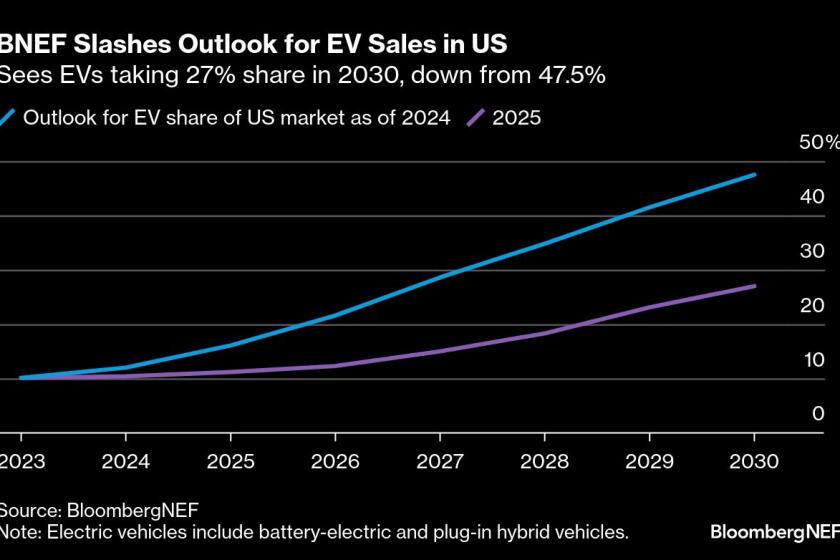Remodeled GM Showcases Future at N.Y. Extravaganza
- Share via
NEW YORK — As is often the case these days, General Motors Chairman Roger B. Smith was on the defensive Tuesday when he plucked this metaphor from his grab bag of explanations for GM’s sagging fortunes.
“I don’t see many hockey teams scoring goals when they’re making player changes,” he sniffed, momentarily quieting the demands of a sometimes hostile gathering of questioners.
Smith was addressing reporters bent on hearing why GM’s multimillion-dollar campaign to restore its competitive edge has instead eroded the automotive giant’s profit and market share and undermined its credibility.
With his hockey metaphor, the embattled Smith dramatized the message GM is so zealously trying to convey this week: The world’s largest auto maker is back.
The company wasn’t at its best for three years while it underwent a controversial overhaul of its technology and organization, officials acknowledged, but they stressed that GM is back to full strength now and eager to show off its multimillion-dollar face lift.
In short, GM knows that it has an image problem. And on Tuesday, the giant of Detroit came to New York to buy back its reputation.
With the $20 million it is estimated to have plunked down, GM has taken over three floors of New York’s posh Waldorf-Astoria Hotel for a hastily arranged, three-day extravaganza that critics quickly dubbed “Rogerama.”
There, surrounded by an exhibit of GM’s cars of the future--fittingly known in the industry as Image Cars--Smith and other top GM executives on Tuesday began the task of refashioning GM’s snarled corporate image.
“This is like the game of Show and Tell we used to play in school,” exuded GM President Robert Stempel. “It’s exciting because there’s no place to hide.”
By the time the show--GM’s largest exhibit of new products ever--ends on Thursday, as many as 14,000 people will have been paraded through the exhibit that GM is officially calling “GM Teamwork & Technology--for Today & Tomorrow.”
Stockholders, mayors, senators, car dealers, journalists, even schoolchildren were invited to get a glimpse of GM’s latest models and its dreams for the future--all wrapped up in a splashy package as high tech as the sleek concept cars that stole the show Tuesday.
Amid the space-age cars and exhibits of the latest in technological wizardry are the hits of the show: a real-life design studio GM brought in for the occasion and a bank of 240 choreographed television screens that regularly lights up with a 10-minute video display.
Featured in the design workshop are engineers, designers and clay sculptors at work on an aerodynamic, two-passenger concept car loaded with such goodies as a satellite navigation system and a voice-activated radio and cellular telephone. Code-named SRV-1, it was frantically conceptualized and built in a mere six weeks--just for the show.
The grid of television screens is even more dazzling. In an elaborate video display, GM tries to tell the story of GM workers’ commitment to what they freely admit is a “scary” overhaul.
“Many times, I don’t understand this,” worries one of the workers interviewed in the video presentation. “It’s so far over our heads,” concedes another. “It’s hard to learn new tricks but it was worth it,” says a third.
To Smith’s thinking, both the new team spirit he purports to have fashioned at GM and the 1988 models on display at the show provide “tangible evidence that GM will maintain its world leadership for years to come.”
But he faced an uphill battle Tuesday in convincing his first guests of the week--several hundred journalists--that his message is anything more than the hyperbole many have come to expect from GM.
In a combative session with reporters, Smith insisted that GM has reversed its sliding market share and will report higher profit this year than a year ago despite shrinking sales.
GM has watched its share of new cars sold in the United States shrink to 32.7% in November from its historical average of about 48%. But Smith and Stempel said Tuesday that GM’s share has since risen to about 36.7%.
Clearly, both are banking on some of their mid-sized 1988 models--notably, the Pontiac Grand Prix, which Motor Trend magazine has designated car of the year--to “grab, excite and satisfy” alienated customers and pull that share up still more. However, it was not the 1988 cars but the “concept vehicles” for the future that grabbed most of the attention at the Waldorf on Tuesday.
These are pure dream machines--a car designer’s attempt at driving in the future with today’s technology.
But many of the concepts and technologies favored by these designers do eventually appear in America’s showrooms.
And at GM, the future is a sleek, sloped car featuring a panorama of glass as strong as sheet metal for better visibility and a feeling of openness.
Gone are the delineations between hood, passenger compartment and trunk. Wheels often are hidden for better aerodynamics. And the egg-shaped concept car of old is now a highly sculptured automobile.
Inside, these cars are what Detroit calls “inside friendly.” The seats are sculptured and mold to passengers for more lateral and lumbar support. Power seats adjust as many as 15 ways. Radios and cellular phones are voice activated as are some steering functions. And there are memory switches for the steering wheel column, pedals and seat positions.
Just as homes now have “entertainment centers” complete with stereos and television, so too, do these cars.
The auto entertainment centers come equipped with both compact discs and tape players.
The outside rear-view mirror has been replaced by an inside color monitor that shows what’s behind.
And on the windshield is a holographic image of the vehicle’s speed, fuel level and turn signals so the driver never has to look away from the road.
Despite severe criticism in financial circles that its reorganization was far too costly, GM “kept on track and remained true to our vision” that GM’s long-term future depended on major short-term repairs, Smith said. “Now we have proof positive--in the products that are here today--of our determination to continue to lead the industry into the 21st Century.”






